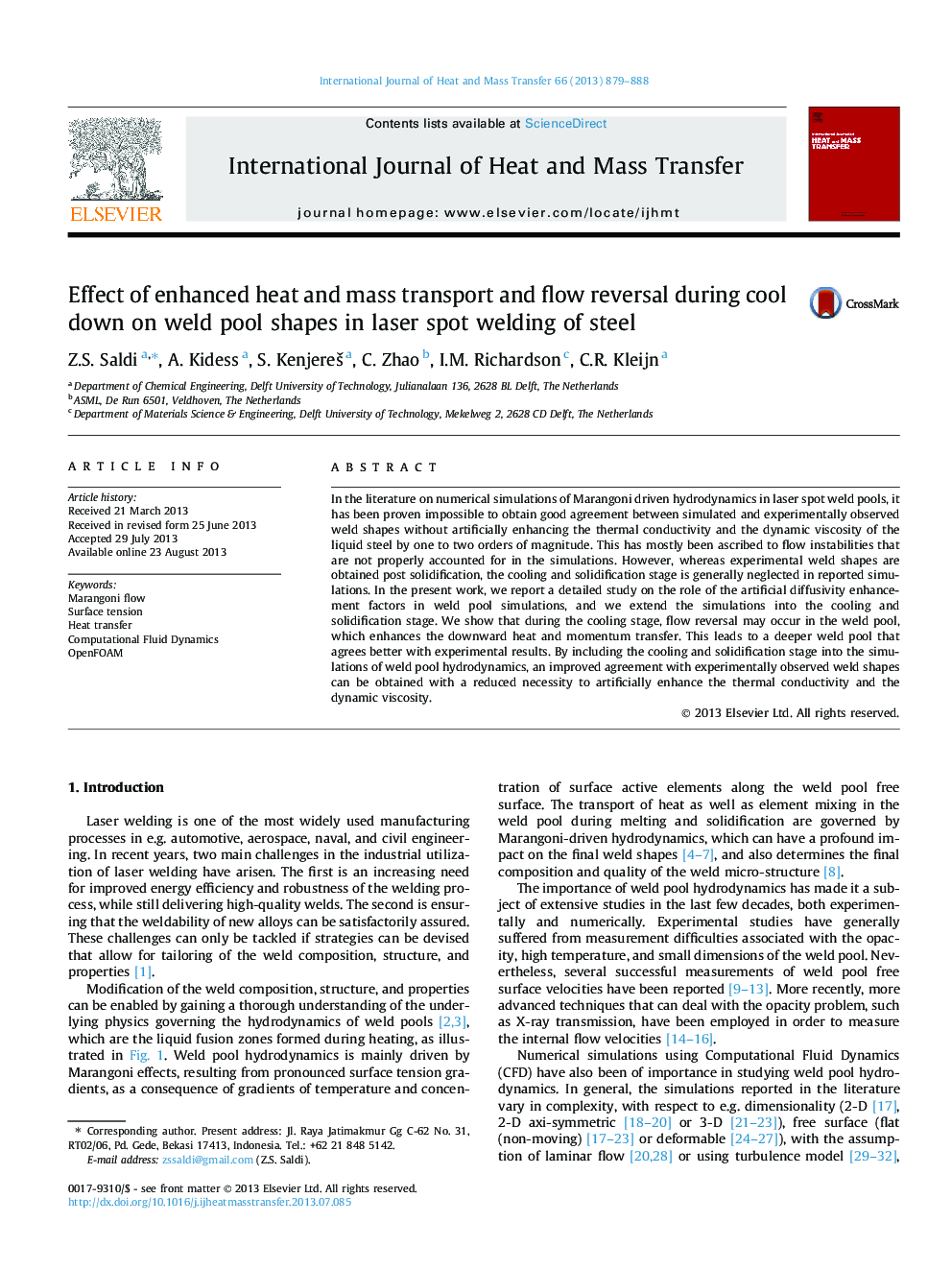| کد مقاله | کد نشریه | سال انتشار | مقاله انگلیسی | نسخه تمام متن |
|---|---|---|---|---|
| 7058241 | 1458076 | 2013 | 10 صفحه PDF | دانلود رایگان |
عنوان انگلیسی مقاله ISI
Effect of enhanced heat and mass transport and flow reversal during cool down on weld pool shapes in laser spot welding of steel
ترجمه فارسی عنوان
اثر انتقال گرما و جرم افزایش یافته و انحراف جریان در هنگام خنک کردن شکل های استوانه جوش در جوشکاری لیزر از فولاد
دانلود مقاله + سفارش ترجمه
دانلود مقاله ISI انگلیسی
رایگان برای ایرانیان
کلمات کلیدی
ترجمه چکیده
در ادبیات مربوط به شبیه سازی های عددی هیدرودینامیکی هدایت شده توسط مارانگونی در استخرهای جوش لیزری، غیرممکن است که توافق خوبی بین شکل های جوش داده شده شبیه سازی شده و تجربی مشاهده شود بدون اینکه به صورت مصنوعی هدایت حرارتی و ویسکوزیته پویای فولاد مایع توسط یک به دو دستورات بزرگ این بیشتر به اشتباهات جریان وابسته است که در شبیه سازی ها مناسب نیستند. با این حال، در حالی که اشکال جوش تجربی پس از خرد شدن به دست می آید، مرحله شستشو و خنک شدن در شبیه سازی های گزارش شده به طور کلی نادیده گرفته می شود. در این مقاله، ما یک مطالعه دقیق در مورد نقش عوامل افزایش نفوذ مصنوعی در شبیه سازی بادهای جوش گزارش می دهیم و ما شبیه سازی ها را در مرحله خنک کننده و جامد سازی گسترش می دهیم. ما نشان می دهیم که در مرحله خنک کننده، تغییر در جریان ممکن است در استخر جوش اتفاق بیفتد که باعث انتقال حرارت و انتقال مولکولی می شود. این منجر به یک استخر جوش عمیق تر می شود که بهتر با نتایج آزمایش همخوانی دارد. با استفاده از مرحله خنک کننده و جامد سازی به شبیه سازی هیدرودینامیک سیلندر جوش، یک توافق بهبود یافته با اشکال جوش داده شده با آزمایش های تجربی می تواند با کاهش ضرورت به صورت مصنوعی افزایش هدایت حرارتی و ویسکوزیته دینامیکی بدست آید.
موضوعات مرتبط
مهندسی و علوم پایه
مهندسی شیمی
جریان سیال و فرایندهای انتقال
چکیده انگلیسی
In the literature on numerical simulations of Marangoni driven hydrodynamics in laser spot weld pools, it has been proven impossible to obtain good agreement between simulated and experimentally observed weld shapes without artificially enhancing the thermal conductivity and the dynamic viscosity of the liquid steel by one to two orders of magnitude. This has mostly been ascribed to flow instabilities that are not properly accounted for in the simulations. However, whereas experimental weld shapes are obtained post solidification, the cooling and solidification stage is generally neglected in reported simulations. In the present work, we report a detailed study on the role of the artificial diffusivity enhancement factors in weld pool simulations, and we extend the simulations into the cooling and solidification stage. We show that during the cooling stage, flow reversal may occur in the weld pool, which enhances the downward heat and momentum transfer. This leads to a deeper weld pool that agrees better with experimental results. By including the cooling and solidification stage into the simulations of weld pool hydrodynamics, an improved agreement with experimentally observed weld shapes can be obtained with a reduced necessity to artificially enhance the thermal conductivity and the dynamic viscosity.
ناشر
Database: Elsevier - ScienceDirect (ساینس دایرکت)
Journal: International Journal of Heat and Mass Transfer - Volume 66, November 2013, Pages 879-888
Journal: International Journal of Heat and Mass Transfer - Volume 66, November 2013, Pages 879-888
نویسندگان
Z.S. Saldi, A. Kidess, S. Kenjereš, C. Zhao, I.M. Richardson, C.R. Kleijn,
